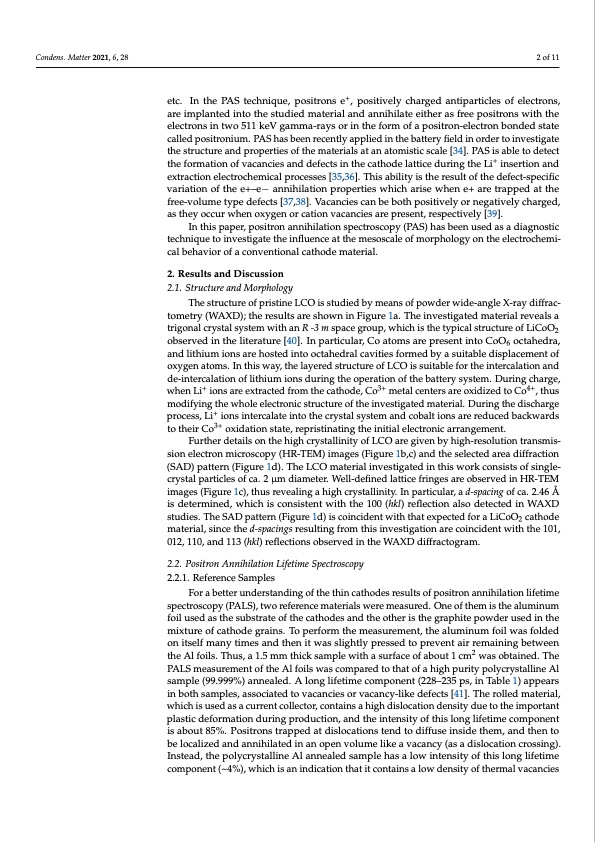
PDF Publication Title:
Text from PDF Page: 002
Condens. Matter 2021, 6, 28 2 of 11 etc. In the PAS technique, positrons e+, positively charged antiparticles of electrons, are implanted into the studied material and annihilate either as free positrons with the electrons in two 511 keV gamma-rays or in the form of a positron-electron bonded state called positronium. PAS has been recently applied in the battery field in order to investigate the structure and properties of the materials at an atomistic scale [34]. PAS is able to detect the formation of vacancies and defects in the cathode lattice during the Li+ insertion and extraction electrochemical processes [35,36]. This ability is the result of the defect-specific variation of the e+–e− annihilation properties which arise when e+ are trapped at the free-volume type defects [37,38]. Vacancies can be both positively or negatively charged, as they occur when oxygen or cation vacancies are present, respectively [39]. In this paper, positron annihilation spectroscopy (PAS) has been used as a diagnostic technique to investigate the influence at the mesoscale of morphology on the electrochemi- cal behavior of a conventional cathode material. 2. Results and Discussion 2.1. Structure and Morphology The structure of pristine LCO is studied by means of powder wide-angle X-ray diffrac- tometry (WAXD); the results are shown in Figure 1a. The investigated material reveals a trigonal crystal system with an R -3 m space group, which is the typical structure of LiCoO2 observed in the literature [40]. In particular, Co atoms are present into CoO6 octahedra, and lithium ions are hosted into octahedral cavities formed by a suitable displacement of oxygen atoms. In this way, the layered structure of LCO is suitable for the intercalation and de-intercalation of lithium ions during the operation of the battery system. During charge, when Li+ ions are extracted from the cathode, Co3+ metal centers are oxidized to Co4+, thus modifying the whole electronic structure of the investigated material. During the discharge process, Li+ ions intercalate into the crystal system and cobalt ions are reduced backwards to their Co3+ oxidation state, repristinating the initial electronic arrangement. Further details on the high crystallinity of LCO are given by high-resolution transmis- sion electron microscopy (HR-TEM) images (Figure 1b,c) and the selected area diffraction (SAD) pattern (Figure 1d). The LCO material investigated in this work consists of single- crystal particles of ca. 2 μm diameter. Well-defined lattice fringes are observed in HR-TEM images (Figure 1c), thus revealing a high crystallinity. In particular, a d-spacing of ca. 2.46 Å is determined, which is consistent with the 100 (hkl) reflection also detected in WAXD studies. The SAD pattern (Figure 1d) is coincident with that expected for a LiCoO2 cathode material, since the d-spacings resulting from this investigation are coincident with the 101, 012, 110, and 113 (hkl) reflections observed in the WAXD diffractogram. 2.2. Positron Annihilation Lifetime Spectroscopy 2.2.1. Reference Samples For a better understanding of the thin cathodes results of positron annihilation lifetime spectroscopy (PALS), two reference materials were measured. One of them is the aluminum foil used as the substrate of the cathodes and the other is the graphite powder used in the mixture of cathode grains. To perform the measurement, the aluminum foil was folded on itself many times and then it was slightly pressed to prevent air remaining between the Al foils. Thus, a 1.5 mm thick sample with a surface of about 1 cm2 was obtained. The PALS measurement of the Al foils was compared to that of a high purity polycrystalline Al sample (99.999%) annealed. A long lifetime component (228–235 ps, in Table 1) appears in both samples, associated to vacancies or vacancy-like defects [41]. The rolled material, which is used as a current collector, contains a high dislocation density due to the important plastic deformation during production, and the intensity of this long lifetime component is about 85%. Positrons trapped at dislocations tend to diffuse inside them, and then to be localized and annihilated in an open volume like a vacancy (as a dislocation crossing). Instead, the polycrystalline Al annealed sample has a low intensity of this long lifetime component (~4%), which is an indication that it contains a low density of thermal vacanciesPDF Image | Positron Annihilation Spectroscopy LiCoO2 Cathode of Lithium-Ion Batteries

PDF Search Title:
Positron Annihilation Spectroscopy LiCoO2 Cathode of Lithium-Ion BatteriesOriginal File Name Searched:
condensedmatter-06-00028.pdfDIY PDF Search: Google It | Yahoo | Bing
Sulfur Deposition on Carbon Nanofibers using Supercritical CO2 Sulfur Deposition on Carbon Nanofibers using Supercritical CO2. Gamma sulfur also known as mother of pearl sulfur and nacreous sulfur... More Info
CO2 Organic Rankine Cycle Experimenter Platform The supercritical CO2 phase change system is both a heat pump and organic rankine cycle which can be used for those purposes and as a supercritical extractor for advanced subcritical and supercritical extraction technology. Uses include producing nanoparticles, precious metal CO2 extraction, lithium battery recycling, and other applications... More Info
| CONTACT TEL: 608-238-6001 Email: greg@infinityturbine.com | RSS | AMP |